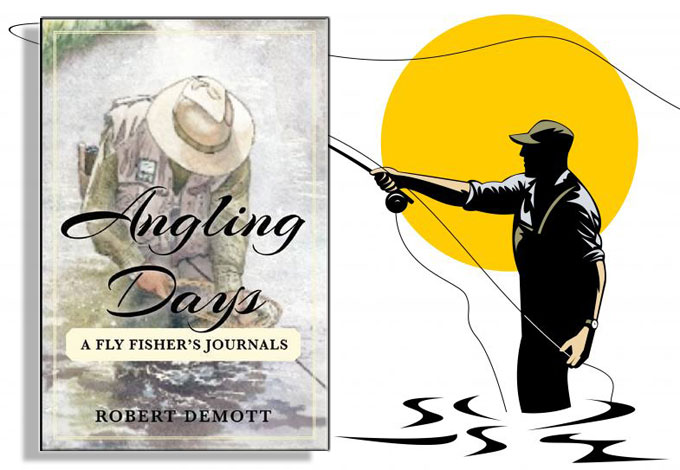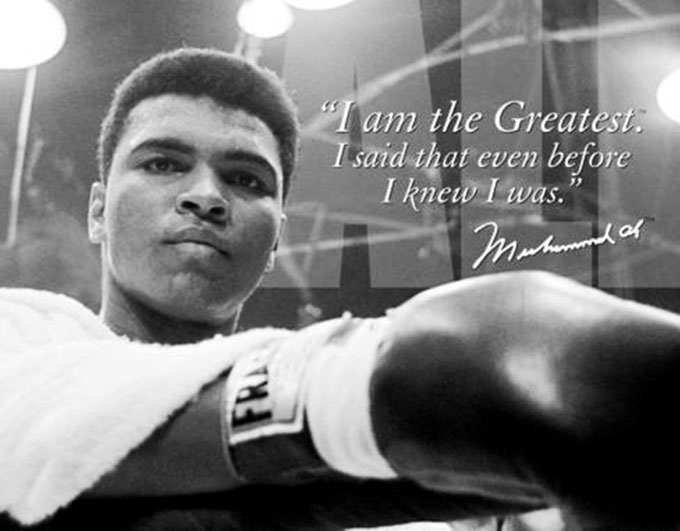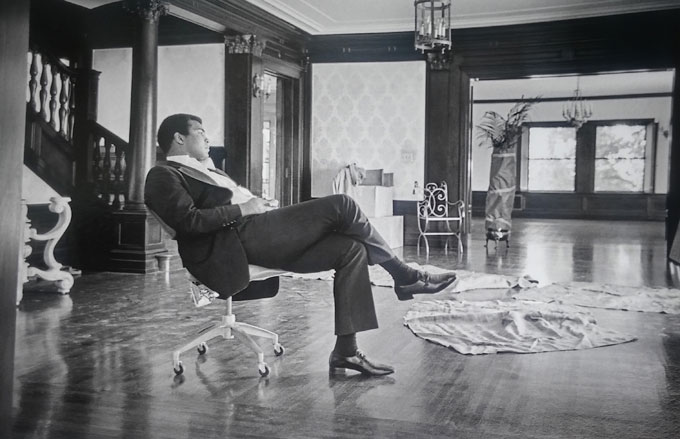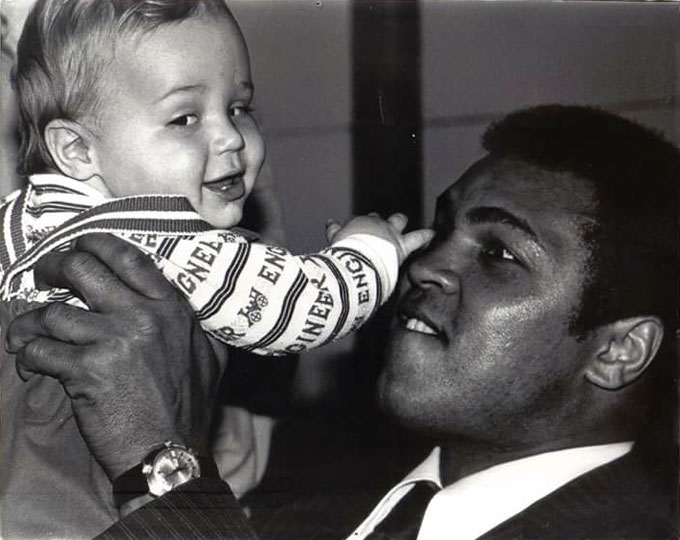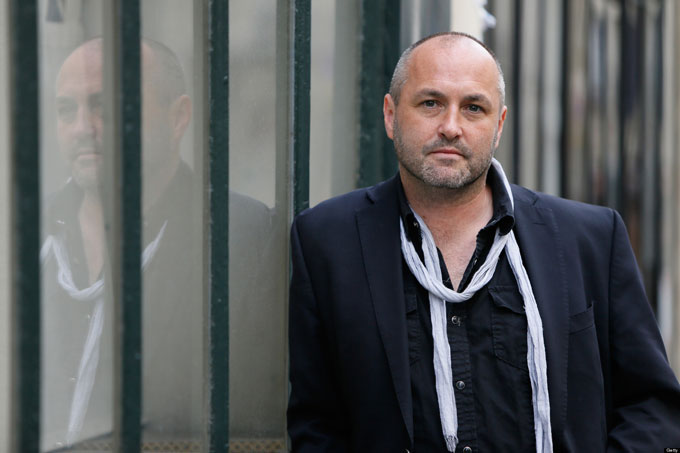Henry David Thoreau, Zane Grey, Ernest Hemingway, and John Steinbeck liked to fish, and the pantheon of American literature is populated by a legion of other sports-loving authors who celebrated the pleasures of fly fishing—like writing, a solitary pursuit requiring patience, persistence, and skill. Few scholars of American literature have made the connection between fly fishing and writing in their careers as convincingly as the poet-scholar Robert DeMott, Kennedy Distinguished Professor Emeritus of American Literature at Ohio University. The author of essential studies of John Steinbeck’s reading and writing, DeMott is also the editor of Working Days, the collection of journals kept by Steinbeck while writing The Grapes of Wrath, and of an anthology, Astream: American Writers on Fly Fishing. All this makes the title of his new book—Angling Days: A Fly Fisher’s Journals—doubly poetic, particularly for fans of John Steinbeck. “No matter how deeply and obsessively I go into fly fishing for trout, a passion of mine for 60 years,” DeMott says, “I try never to lose sight of John Steinbeck’s comment in a lovely little essay of his called ‘On Fishing,’ that ‘any man who pits his intelligence against a fish and loses has it coming.’” Angling Days will be released by Skyhorse Publishing on June 28. Whether or not you love fly fishing like DeMott, it belongs on your John Steinbeck shelf.
Archives for June 2016
Robert DeMott’s Love Affair With American Literature, Steinbeck, and Fly Fishing
John Steinbeck House in Salinas, California Receives Award from Trip Advisor Site
John Steinbeck won literary honors during his lifetime, including a Nobel Prize. Now the house where he was born and reared in Salinas, California has received a high accolade from TripAdvisor.com, one of the hospitality industry’s most heavily used consumer websites. People who visited the Steinbeck House restaurant and gift shop during the past 12 months rated their experience as “excellent” or “very good” frequently enough to earn Trip Advisor’s Certificate of Excellence for the thriving Salinas venue. John Steinbeck, who could be critical of business in his writing, would be gratified. Education and enjoyment, not money, motivated members of the Valley Guild to buy the Steinbeck home, restore it, and operate an intimate restaurant, staffed by a professional chef and volunteers servers, where answers to questions about Steinbeck come with the meal. Toni Bernardi, president of the nonprofit organization, explains: “We appreciate our guests and we all strive to honor the memory of John Steinbeck’s life and work.” Today honoring John Steinbeck turns out to be a good way to pay the bills—and garner praise from the hospitality industry—in Salinas, California.
Muhammad Ali and John Steinbeck, Together, in This Week’s Hollywood Reporter
John Steinbeck boxed when he was in college, but he disagreed with Muhammad Ali, the greatest boxer of a later time, about America’s intervention in Vietnam when that war became controversial. At their peak the two figures were alike, however. As fans will be reminded when they read this week’s Hollywood Reporter, each man was the greatest in his field, and both displayed courage under fire for convictions that made others angry. The online edition of the magazine leads with an item about John Legend and Andra Day’s new arrangement of “The Greatest Love of All,” a song originally written for The Greatest, the 1977 movie about Muhammad Ali. The next piece on the page looks back even further, to the heyday of the Garden of Allah, the Hollywood hotel with the famous pool where actors, writers, and musicians went to hook up and get wet in the 1930s and 40s: “George S. Kaufman, F. Scott Fitzgerald, John Steinbeck, William Faulkner, Ernest Hemingway and Dorothy Parker all flocked to the Garden for its permissive (read: alcohol-soaked) atmosphere and smart, starry clientele.” This association of Muhammad Ali and John Steinbeck may be accidental, but Steve Hauk, the writer of fiction based on John Steinbeck’s life, recalls meeting Ali for real in a telling true-life story—“The Day I Met Muhammad Ali”—published here for the first time.
The Day I Met Muhammad Ali: A Surreal Experience
In the fall of 1962 I was at Los Angeles City College writing for the school newspaper. In an article I predicted that a young boxer named Cassius Clay, eventually to be known as Muhammad Ali, would lose his upcoming fight to the crafty Archie Moore. I said the brash, youthful Clay would hobble across the ring at the end of the fight to congratulate the grandfatherly Moore. That led to a surreal encounter with Ali, the three-time heavyweight champion who died on June 3 after battling Parkinson Disease for three decades.
I predicted that a young boxer named Cassius Clay, eventually to be known as Muhammad Ali, would lose his upcoming fight to the crafty Archie Moore.
Los Angeles was a hotbed of prize fighting in the 1960s. The heavyweight division in particular was crowded with talented fighters, many of whose lives would end prematurely. Though Parkinson Disease had a name, chronic traumatic encephalopathy was unfamiliar. Fighters ended up suffering from CTE anyway, and Ali eventually contracted Parkinson Disease, a degenerative condition with multiple causes and no cure.
Los Angeles was a hotbed of prize fighting in the 1960s. The heavyweight division in particular was crowded with talented fighters, many of whose lives would end prematurely.
Few fighters were able to hit Ali in 1962, but head trauma was already, or was becoming, an issue for boxers such as Joey Orbillo, Jerry Quarry, and Eddie Machen. Quarry, saddled with the Great White Hope label, would eventually die of what was described at the time as dementia pugilistica. He became helpless and required round-the-clock care. Machen, a fighter of ballet-like grace, took terrible beatings toward the end of his career, spent time in a psychiatric ward, and fell to his death from an apartment window at age 40.
Few fighters were able to hit Ali in 1962, but head trauma was already, or was becoming, an issue for boxers such as Joey Orbillo, Jerry Quarry, and Eddie Machen.
Orbillo, who fought Quarry while on leave from service in Vietnam, courageously walked point during combat missions–an extremely dangerous duty which he volunteered for because, he reasoned, he was single and his comrades had families. He took such a severe beating from Quarry that he was held back from combat, and another soldier was killed taking the point in his place. Mourning the loss, Orbillo credited Quarry with saving his life.
Life at Los Angeles City College in 1962
These tragic stories–and there were many in the heavyweight division–had yet to be told when I wrote about the Ali-Moore fight for the Los Angeles City College paper. Thinking back, I have no idea why I even wrote the column. Ali was of course famous, but there were few signs of his future greatness. And Los Angeles was full of celebrities, some of whom—David Jansen and James Coburn, for instance—could be seen walking across campus or sitting in coffee houses along Vermont Avenue.
These tragic stories had yet to be told when I wrote about the Ali-Moore fight for the Los Angeles City College paper.
Clint Eastwood, Donna Reed, Paul Winfield–a superb Othello–and Morgan Freeman had taken classes at Los Angeles City College. So had the poet Charles Bukowski, as well as musicians Charles Mingus, John Williams, and Leonard Slatkin. While working at the newspaper I covered a lecture given in the stadium by writer Aldous Huxley. It was one of his last. During my interview with Huxley I realized how terribly ill he was.
The Day Muhammad Ali Walked through the Door
Many of the buildings at Los Angeles City College were relatively new at the time, but the newspaper office was located in a long, narrow prefab with tiny windows. The day my piece on the Ali-Moore fight appeared, I was working on another story when I heard someone chanting “I want Hauk! I want Hauk!” in the distance. The voice was familiar. I stepped outside and saw Ali approaching the building, surrounded by excited students and waving a copy of the paper.
The newspaper office was located in a long, narrow prefab with tiny windows. I heard someone chanting ‘I want Hauk!’ in the distance. The voice was familiar.
“Are you Hauk?” Ali said. “Now don’t lie to me–I can see you are! How could you write this–me lose to Archie Moore? Don’t you know I’m the greatest? Can’t you see I’m pretty? Don’t you know I’m going to give that old man Archie Moore the spanking of his life?”
‘Are you Hauk?’ Ali said. ‘Now don’t lie to me. I can see that you are!’
I replied that it was a columnist’s job to have an opinion. Ali laughed and said that was fine, but he’d prove me wrong. Then he led the students back across the campus. Later he returned to the newsroom alone, sat down, and introduced himself. He was soft-spoken, a bit shy, and quick to smile.
I replied that it was a columnist’s job to have an opinion. Ali laughed and said that was fine, but he’d prove me wrong.
He went on to beat Archie Moore in four rounds, just as he had promised. At the end of the fight I was happy to hear he walked–not hobbled–across the ring to embrace the older man. It bothered me that he shrugged off the win by saying he had beaten “an old man.” Moore deserved better. Ali in those days could be a touch cruel, a quality he wrung from himself and turned into amazing compassion.
Parkinson Disease, Gentleness, and Death
As the years passed Ali began to take the kind of punches that so damaged other fighters, some of them heavyweight champions. Those magnificent heavyweights were killing each other. Then Ali was diagnosed with Parkinson Disease, and one can’t help from feeling it had been hurried along by all of those punches.
As the years passed Ali began to take the kind of punches that had so damaged the other heavyweights, some of them champions.
That he held on for three decades was a testament to Muhammad Ali’s will and resolve, which he called on for causes far beyond the parameters of boxing–and an instinctive gentleness, humor, and kindness, which I had been fortunate enough to experience.
The Photography of Ralph Elliott Starkweather
In a distinguished career ranging the world, Ralph Elliott Starkweather has taken photographs for Life, National Geographic, Gourmet, Smithsonian, and many other magazines. He also had a close relationship with Muhammad Ali, traveling with the late fighter and even recording him moving into a new home.
Ralph explains how the lead photo, published here for the first time, was taken: “I went to his home to document his moving into a place called Rossmore in Los Angeles. It was exclusive at the time–guard-gated. My favorite photo because for 10 minutes he was on his own left to his thoughts. In a way like a Black Buddha deep in meditation.”
The other photo is of Ali hoisting Starkweather’s nephew, Chris English, 37 years ago at Los Angeles International Airport. Ali would have been about 37 or 38 at the time, halfway through his life.
Colum McCann Compares New York Times Writer’s Book to The Grapes of Wrath
“Your only weapon is your work.” That was John Steinbeck’s advice to writers in a 1957 letter to Dennis Murphy, the son of Steinbeck’s boyhood pal John Murphy. Like Steinbeck’s mother, the Murphy family of Salinas had Irish roots, and Irishness figured later in Steinbeck’s autobiographical writing. So it’s appropriate that Colum McCann—the Irish author (shown here) who posts a weekly letter of advice to young writers on his website—makes such a point of comparing New York Times investigative reporter Dan Barry to John Steinbeck in blurbs and interviews about Barry’s new book, The Boys in the Bunkhouse: Servitude and Salvation in the Heartland. Listen to Colum McCann’s May 23 New York Times Insider interview— “The Closest We Have to Steinbeck” —and learn how Dan Barry’s expose of one recent case of human exploitation in Iowa echoes Of Mice and Men and The Grapes of Wrath—the weapon John Steinbeck used to expose living conditions for victim labor in California 80 years ago.
